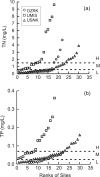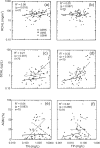Influence of Environmental Factors on Biotic Responses to Nutrient Enrichment in Agricultural Streams
- PMID: 22457568
- PMCID: PMC3307628
- DOI: 10.1111/j.1752-1688.2010.00430.x
Influence of Environmental Factors on Biotic Responses to Nutrient Enrichment in Agricultural Streams
Abstract
The influence of environmental factors on biotic responses to nutrients was examined in three diverse agricultural regions of the United States. Seventy wadeable sites were selected along an agricultural land use gradient while minimizing natural variation within each region. Nutrients, habitat, algae, macroinvertebrates, and macrophyte cover were sampled during a single summer low-flow period in 2006 or 2007. Continuous stream stage and water temperature were collected at each site for 30 days prior to sampling. Wide ranges of concentrations were found for total nitrogen (TN) (0.07-9.61 mg/l) and total phosphorus (TP) (<0.004-0.361 mg/l), but biotic responses including periphytic and sestonic chlorophyll a (RCHL and SCHL, respectively), and percent of stream bed with aquatic macrophyte (AQM) growth were not strongly related to concentrations of TN or TP. Pearson's coefficient of determination (R(2)) for nutrients and biotic measures across all sites ranged from 0.08 to 0.32 and generally were not higher within each region. The biotic measures (RCHL, SCHL, and AQM) were combined in an index to evaluate eutrophic status across sites that could have different biotic responses to nutrient enrichment. Stepwise multiple regression identified TN, percent canopy, median riffle depth, and daily percent change in stage as significant factors for the eutrophic index (R(2) = 0.50, p < 0.001). A TN threshold of 0.48 mg/l was identified where eutrophic index scores became less responsive to increasing TN concentrations, for all sites. Multiple plant growth indicators should be used when evaluating eutrophication, especially when streams contain an abundance of macrophytes.
Figures







Similar articles
-
The influence of nutrients and physical habitat in regulating algal biomass in agricultural streams.Environ Manage. 2010 Mar;45(3):603-15. doi: 10.1007/s00267-010-9435-0. Epub 2010 Feb 9. Environ Manage. 2010. PMID: 20143065 Free PMC article.
-
[Effect of Nutrient Loadings on the Regulation of Water Nitrogen and Phosphorus by Vallisneria natans and Its Photosynthetic Fluorescence Characteristics].Huan Jing Ke Xue. 2018 Mar 8;39(3):1180-1187. doi: 10.13227/j.hjkx.201705111. Huan Jing Ke Xue. 2018. PMID: 29965462 Chinese.
-
Observer rating of recreational use in wadeable streams of New York State, USA: implications for nutrient criteria development.Water Res. 2015 Feb 1;69:195-209. doi: 10.1016/j.watres.2014.11.022. Epub 2014 Nov 24. Water Res. 2015. PMID: 25482912
-
Interactive effects of temperature and nutrients on the phytoplankton community in an urban river in China.Environ Monit Assess. 2019 Oct 29;191(11):688. doi: 10.1007/s10661-019-7847-8. Environ Monit Assess. 2019. PMID: 31664528 Review.
-
A review of sediment and nutrient concentration data from Australia for use in catchment water quality models.Mar Pollut Bull. 2012;65(4-9):101-16. doi: 10.1016/j.marpolbul.2011.08.009. Epub 2011 Sep 1. Mar Pollut Bull. 2012. PMID: 21889170 Review.
Cited by
-
Response of chlorophyll a to total nitrogen and total phosphorus concentrations in lotic ecosystems: a systematic review protocol.Environ Evid. 2017;6(18):1-13. doi: 10.1186/s13750-017-0097-8. Environ Evid. 2017. PMID: 31019679 Free PMC article.
-
Linking biological integrity and watershed models to assess the impacts of historical land use and climate changes on stream health.Environ Manage. 2013 Jun;51(6):1147-63. doi: 10.1007/s00267-013-0043-7. Epub 2013 Apr 23. Environ Manage. 2013. PMID: 23609304
-
Nutrient limitation of algae and macrophytes in streams: Integrating laboratory bioassays, field experiments, and field data.PLoS One. 2021 Jun 18;16(6):e0252904. doi: 10.1371/journal.pone.0252904. eCollection 2021. PLoS One. 2021. PMID: 34143815 Free PMC article.
-
Health assessment using aqua-quality indicators of alpine streams (Khunjerab National Park), Gilgit, Pakistan.Environ Sci Pollut Res Int. 2017 Feb;24(5):4685-4698. doi: 10.1007/s11356-016-8186-8. Epub 2016 Dec 14. Environ Sci Pollut Res Int. 2017. PMID: 27975201
References
-
- Allan JD. Stream Ecology: Structure and Function of Running Waters. Dordrect, The Netherlands: Kluwer Academic Publishers; 1995.
-
- Arar EJ, Colling GB. U.S. Environmental Protection Agency Method 445.0, In Vitro Determination of Chlorophyll a and Pheophytin a in Marine and Freshwater Algae by Fluorescence, Revision 1.2. Cincinnati, Ohio: U.S. Environmental Protection Agency, National Exposure Research Laboratory, Office of Research and Development; 1997. http://www.epa.gov/microbes/m445_0.pdf, accessed February 2010.
-
- Biggs BJF. The Contribution of Flood Disturbance, Catchment Geology, and Land Use to the Habitat Template of Periphyton in Stream Ecosystems. Freshwater Biology. 1995;33:419–438.
-
- Biggs BJF. Patterns in Benthic Algae in Streams. In: Stevenson JR, Bothwell ML, Lowe RL, editors. Algal Ecology: Freshwater Benthic Ecosystems. San Diego: Academic Press; 1996a. pp. 31–76.
-
- Biggs BJF. Hydraulic Habitat of Plants in Streams. Regulated Rivers: Research and Management. 1996b;12:131–144.
LinkOut - more resources
Full Text Sources
